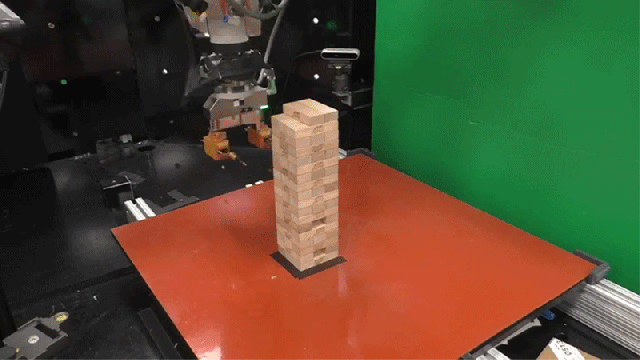A steady hand is needed to play a game like Jenga without toppling the tower, but being a successful block-stacker also requires a fine-tuned sense of touch as you try to find the perfect piece to remove. Until recently it meant robots relying solely on visual data weren’t actually great at playing Jenga (yay, humanity!) but by adding a sense of touch, researchers have once again given automatons the advantage. (Never mind.)
From day one, humans learn to interact with the world around them through a combination of sight and touch. It takes years of trial and error to fully grasp the physics that govern our day-to-day lives, but eventually we learn the ins and outs of gravity, friction, and other forces at play.
You probably don’t give a lot of thought to the physical senses you rely on to probe the blocks in a Jenga tower, but imagine trying to determine the best move by only looking at the tower, it would be toppled at every turn.
In a paper published in the AAAS journal, Science Robotics, researchers at the Massachusetts Institute of Technology in Cambridge, Massachusetts, led by Nima Fazeli, have developed a robot that can learn to play Jenga the same way humans do by relying on both visual clues, as well as physical feedback from our fingers. In the case of this robot arm, the fingers were a pair of grasping probes that can sense the movements and friction of a block it pokes, the same way a human player would.
Visual data about the tower was still important for the robot’s success — imagine trying to play Jenga while wearing a blindfold—so in addition to being touchy feely it also relied on a camera capturing the tower’s shape and position over time. But what’s most impressive about this research is that the bot wasn’t explicitly taught how to play Jenga, or how the various wooden blocks move or interact with each other.
The ability to feel also facilitated the robot’s ability to learn how to play all on its own, both in terms of finding a block that was loose enough to remove, and repositioning it on the top of the tower without upsetting the delicate balance. In as little as a 100 games, it figured out that trying to move a block that wouldn’t easily slide was not beneficial to the game’s progression.
Playing Jenga is not exactly high on the list of reasons for owning a robot, but the research will help make bots more adaptable for other tasks. In factories, robots are currently programmed to perform very specific motions and actions to accomplish very specific jobs.
In the long run it can be a more cost-effective solution for a large company than paying a human to do the same monotonous work, but do we want 1,000 robots in our homes all programmed to do one specific chore? Obviously not. Teaching one robot to learn to do a multitude of tasks, and adapt to an ever-changing number of variables, is a much better approach.
